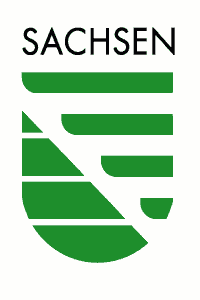Lebendige Wände (Living Walls)
Green facades for multifunctional climate adaptation in the city
Personnel
Department of Urban and Environmental Sociology
Prof. Dr. Uwe Schlink (head)
Raphael Karutz
Niels Wollschläger
Department of Economics
Heinrich Zozmann
Duration
10/2021 − 12/2022
Status

This measure is co-financed with tax funds on the basis of the budget passed by the Saxon state parliament.
Background and objective
Climate change presents unprecedented challenges to municipalities, especially due to the hot and dry summers of recent years. These place stress on the population, the economy, and nature in the city. Green facades promise versatile contributions to effective urban climate adaptation: they cool the environment on hot days, increase air quality and biodiversity, and contribute to the health and well-being of residents. Despite numerous suitable facades, there is hardly any significant use of this potential.
This is due to various hurdles: Green facades are often perceived as an additional economic burden. They are also often not professionally implemented and maintained. When implementing projects, the irrigation concept, which is important for climate-adapted green facades, is frequently disregarded. As a result, overgrown or dried-out green facades increase obstacles and acceptance problems among owners and residents.
Approaches to solving these problems are being developed and tested in the course of the project. Coordinated by the Helmholtz Center for Environmental Research (UFZ), model facades of the Leipziger Wohnungs- und Baugesellschaft (LWB) are being greened. The environmental protection association Ökolöwe and the civic network Wir im Quartier are contributing expertise and civil society involvement to the consortium. The project team is advised by the Leipzig-based company FassadenGrün e.K, a leading provider of facade greening.
Barrier analysis and co-creation of solutions
In the course of the project, obstacles and implementation difficulties are identified through a systematic literature and inventory analysis. Thereupon, experts and different stakeholders (homeowners, gardening companies, city administration, civil society initiatives) develop innovative solutions to overcome these obstacles in co-creation workshops. The solution approaches include procedures for involving residents, irrigation solutions (e.g., rainwater cistern, traffic light system), and processes for ensuring proper maintenance.
Pilot projects
These processes will then be applied to several model walls: Four exposed facades from the LWB's prefabricated building stock will be equipped with climbing aids and planted with greenery in spring 2022. Exemplary green wall types will be created, such as a biodiversity wall or a retention wall. The needs of local residents will be assessed through surveys, and the model projects will be researched from an interdisciplinary perspective. Sensors will be installed on the greened facades and on several comparison walls without as well as with fully developed greening to experimentally determine the cooling effect of facade greening. The measured data will be integrated into a microclimatic simulation model that takes into account varying environmental conditions and allows for estimates of the effects at the neighborhood level. In a second round of co-creation workshops, the experiences from the implementation of the model projects will be evaluated.
Transfer and scaling
The results of the project will be comprehensive, scientifically robust information on the costs (economic) and benefits (economic, social, climatic) of facade greening, as well as a collection of best-practice approaches and recommendations for action. The installation of the measurement system enables continuous monitoring for further demo and research purposes. Overall, reproducible and scalable concepts are created that contribute to effective adaptation to climate change. Through the project, a façade greening cluster of companies, research and civil society will be created in Leipzig, resulting in new business models and economic effects.
